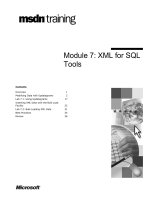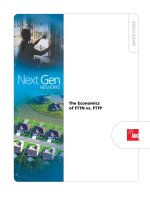Tài liệu Central Office Implications for Deploying FTTP pdf
Bạn đang xem bản rút gọn của tài liệu. Xem và tải ngay bản đầy đủ của tài liệu tại đây (170.93 KB, 6 trang )
Central Office Implications
for Deploying FTTP
WHITE PAPER
The successful deployment of any flexible, cost-effective fiber-to-the-premise (FTTP)
network requires thoughtful decisions regarding all segments of the network, from the
optical line terminal (OLT) in the central office to the optical network terminal (ONT)
attached to each home and everything in between. While much attention is focused on
the distribution and access elements within the outside plant (OSP) network, it’s also
important to consider the implications of FTTP architectures within the central office (CO).
Probably the biggest mistake any carrier can make is believing that an FTTP does not
require the same flexibility as a transport network. However, a mindset that the FTTP
network does not require the same level of access, flexibility, and protection given to
other aspects of the network is too often the mindset of some network planners when
first looking at deploying an FTTP network. In reality, however, FTTP architectures pose
significant implications for the CO in meeting the same levels of performance required for
transport segments.
First up – architecture decisions
Before specific product selections can be made, some critical network architecture
decisions are necessary. These key decisions involve connection strategies, flexibility in
terms of test access points, and WDM positioning. Deciding on a CO network
architecture for FTTP networks requires the planner to perform a balancing act. The goal
in any network is to minimize capital expenses and long-term operational expenses, while
achieving the highest possible levels of flexibility within the network. The basic function of
an FTTP network in the central office is to connect the OLT equipment to the OSP fibers,
deploying WDM somewhere in the middle to enable voice and data signals to be
combined with video signals.
Central Office Implications
for Deploying FTTP
Figure 1
Video Optical
Line Terminal
(P–OLT)
Packet Optical
Line Terminal
(P–OLT)
Raceway
(FiberGuide
®
System)
Video WDM
(VAM)
Fiber
Distribution
Frame (NGF)
Fiber Entrance
Cabinet (FEC)
Central Office Implications for Deploying FTTP
Page 2
As shown, the video WDM would be placed in a panel in
the same frame as the OLT equipment. A patch cord
connects the OLT equipment to the inputs of the video
WDM. The common port on the video WDM is, in turn,
connected to the back side of the equipment FDF, where
a crossconnect patchcord connects OLT ports to the
designated OSP ports. The obvious advantage is the need
for only one patch cord running from the OLT frame to
the FDF for every passive optical network (PON) circuit.
However, the down side to this architecture is that four
connector pairs are required and network flexibility is
greatly reduced. One critical assumption required for this
strategy is that the voice/data OLT will be located very
close to the video OLT associated with it. While this may
seem easy in a field trial or small roll-out scenario, full-
scale FTTP deployment may prove otherwise. The video
WDM must be placed in a location that provides any
voice/data OLT easy connectivity to any video OLT,
regardless of its location in the CO.
A better approach to placing the video WDM at the OLT
frame is to place it in the FDF line-up. This method offers
many advantages to an FTTP network. Placing the video
WDM in the crossconnect FDF line-up in the equipment
frame provides the lowest overall cost, the minimum
number of optical connectors, and the greatest amount
of network flexibility, as shown below.
In the above scenario, the video WDM is placed in the
equipment frame in the FDF line-up. Patch cords connect
the OLT equipment to the inputs of the video WDM. A
crossconnect patch cord is used to connect the video
WDM common port to the designated OSP port. There is
an immediate advantage of requiring only three
connector pairs while maintaining maximum flexibility.
Since the video WDM is located at the FDF and all OLT
patch cords are routed directly to the FDF, greater
flexibility is provided regarding how the OLTs are
combined and configured. Any OLT can be easily
combined with any other OLT, regardless of its location in
the CO. Now that the architecture decisions have been
addressed, the connectivity product selection can begin.
2
3
A look at the numbers
Before any true fiber connectivity product selection can
occur, network planners must carefully consider the
numbers involved with full-scale FTTP deployment. As
discussed previously and outlined below, planning the
network layout and product selections must be based on
long-term needs rather than initial deployment numbers.
Consider the number of OLTs:
• Current and future possibilities
• 3200 homes passed will require at least 100 WDMs,
more likely 120 or more
• Plan ahead by reserving floor space for future
expansions or fewer homes per OLT
Considering incoming OSP fiber
counts:
• OSP cable should be sized to meet future demands
• 3200 homes passed requires at least 100 fibers back
to the CO, with up to 432 more likely depending on
network strategy
• OSP cable fiber counts will be overbuilt to ensure
future capacity requirements can be met without
installing additional fiber
• Non-FTTP-related services on the cable
The incoming OSP cables used for the FTTP network will
have large fiber counts for accessing as many homes as
possible. Since a major expense to any network is
burying the OSP cable in the ground, any OSP cable
installed should be sized for future service needs. For
instance, reaching a neighborhood of 3200 homes, an
OSP cable would minimally require 100 fibers (1 per 32
homes) based on full utilization of the 1x32 optical
splitters used in the OSP distribution cabinets. However,
considering take rates, spare fibers, splitter usage, future
service offerings, distance from C/O and other
unknowns, the number of fibers in the OSP cable would
more likely end up being closer to 1 per 8 homes.
Also, these OSP cables will likely pass several other areas,
including businesses, providing even more opportunities
over the same cable being used for the FTTP network.
Potential business customers that can be serviced over
the same cable cannot be overlooked. Therefore, back in
the CO, each fiber needs to be easily accessible by all
areas of the network – not just the FTTP-designated
equipment. Additional flexibility, built into the central
office, will enable the carrier to get the most out of the
fiber, including the ability to use the same fiber to take
advantage of any non-FTTP service opportunities that
may arise.
Due to the large potential fiber counts in the C/O and
floor space availability issues, FTTP networks will require
high-density fiber distribution frames that enable the
maximum number of terminations available in the least
amount of space possible. While a high-density FDF
system may be important for reducing physical space
required for FTTP deployments, the density gain cannot
be achieved at the sacrifice of fiber cable management
within the frame.
Critical cable management
Any high-density fiber distribution frame must be
functionally designed to accommodate the large number
of incoming fibers and the maximum number of
terminations associated with FTTP infrastructure – not
simply a standard frame with more terminations added.
Also worth mentioning is that unlike traditional OSP
networks, FTTP networks are not protected – there is no
diverse path to provide network redundancy in the event
of a major outage. This fact changes the way services are
provided and maintenance is accomplished within the
CO for FTTP architectures.
For example, typical service outage windows may not be
available for performing maintenance in an FTTP
network. Rather, because there is just one link per
customer, technicians may delve into the network any
time of day to do required maintenance. This makes easy
accessibility a critical attribute for servicing or
reconfiguring the FTTP network with minimal impact on
adjacent networks.
Creating a high-density FDF – defined as 1440 or more
terminations – is technically very easy. Creating a
functional high-density FDF with good cable
management features that enables technicians to quickly
and efficiently turn-up, test, and reconfigure the network
is more complicated.
Telcordia’s GR-449-CORE, Issue 2, July 2003, Generic
Requirements and Design Considerations for Fiber
Distribution Frames, contains design guidelines and test
requirements for high-density FDF systems. These
requirements help ensure proper functionality and
performance of a high-density FDF system in a high fiber-
count network.
There are four key aspects of cable management to
consider when evaluating any FDF or panel product:
bend radius protection, connector access, cable routing
paths, and physical protection.
Central Office Implications for Deploying FTTP
Page 3
Central Office Implications for Deploying FTTP
Page 4
Bend radius protection – Proper bend radius protection
as defined in Telcordia GR-449-CORE, Issue 2, requires all
bends made by a fiber within the network to be
protected with a radius of 1.5-inches or 10 times the
outside diameter (OD) of the cable, whichever is greater.
This protection is critical to ensure long-term optical
performance and the ability to support future high-speed
services.
Connector access – Physical connector access is very
difficult to achieve in a high-density frame. The system
must be designed to allow tool-less access to front and
rear connectors without disturbing adjacent fibers or
connectors. Easy front and rear connector access is
needed for service turn-up and connector cleaning – very
critical to an FTTP network, since much of the access for
turn-up and troubleshooting will occur during normal
business hours. Telcordia GR-449-CORE, Issue 2, provides
testing requirements at OC-768 transmission rates to
ensure a system provides good connector access without
interfering with adjacent circuits.
Cable routing paths – Cable routing paths within any
FDF-related system must be clear and easy to follow. The
quality of the cable routing paths within the system will
be the difference between congested chaos and neatly
routed, easily accessed patch cords. In high-density FDF
systems, the need to easily follow cable routing paths is
magnified due to the large number of fibers present.
Telcordia GR-449-CORE, Issue 2 also provides design and
test requirements to validate the quality of the cable
routing paths within a fiber distribution frame system
Physical safety – Laser safety must also be a concern in
FTTP networks, since high-power lasers used in the
analog video OLT can be potentially harmful to
technicians. Since infrared lasers are not visible to
the human eye, it’s important to take precautions when
exposure is possible. Fiber distribution frames need to
have built-in laser eye safety features, ensuring
connectors don’t point directly at technicians minimizing
the possibility of technician being exposed to high power
laser radiation. Designs that have connector ports
contained within a tray or other enclosure and pointing
side-to-side, rather than straight out of the panel, help
protect technicians, regardless of their level of training or
awareness.
Success in the CO
It cannot be overstated that FTTP networks require similar
if not more stringent cable management attributes as any
OSP network that comes into the CO. Flexibility and
accessibility are particularly important since, although
FTTP may be the application of the day, non-FTTP
applications cannot be overlooked as additional revenue
sources over the same fiber.
Carriers are beginning to realize the full potential of FTTP
networks and are embracing the fact that changes are
imminent. Whatever is done today will be done
differently tomorrow. Designing FTTP networks with
proper care and planning will provide added benefits to
the carriers maximum efficiency, easy access, high
flexibility, and lower cost.
ADC Telecommunications, Inc., P.O. Box 1101, Minneapolis, Minnesota USA 55440-1101
Specifications published here are current as of the date of publication of this document. Because we are continuously
improving our products, ADC reserves the right to change specifications without prior notice. At any time, you
may verify product specifications by contacting our headquarters office in Minneapolis. ADC Telecommunications,
Inc. views its patent portfolio as an important corporate asset and vigorously enforces its patents. Products or
features contained herein may be covered by one or more U.S. or foreign patents. An Equal Opportunity Employer
1291110 09/05 Revision © 2004, 2005 ADC Telecommunications, Inc. All Rights Reserved
Web Site: www.adc.com
From North America, Call Toll Free: 1-800-366-3891 • Outside of North America: +1-952-938-8080
Fax: +1-952-917-3237 • For a listing of ADC’s global sales office locations, please refer to our web site.
WHITE PAPER









